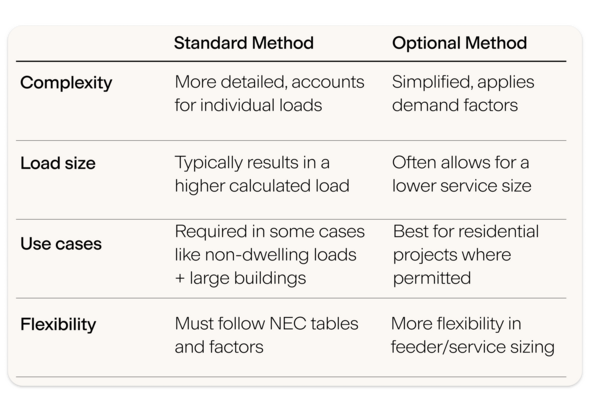NEC Article 220 might not be something you reference every day, but it’s the backbone of residential and commercial load calculations and it’s worth brushing up on when you can. Whether you’re upgrading a panel, adding new loads, or putting together a permit set, Article 220 is where you go to size services, feeders, and branch circuits properly.
This article isn’t a full tutorial, but provides a quick summary of how NEC Article 220 is structured, plus a few reminders and tips we’ve gathered from the field.
You likely learned how to complete load calcs when getting licensed. Even if you don’t do them often, doing them right is key. A proper calculation helps avoid undersizing, failed inspections, or pushback from AHJs.
This article isn’t a full tutorial, but provides a quick summary of how NEC Article 220 is structured, plus a few reminders and tips we’ve gathered from the field.
You likely learned how to complete load calcs when getting licensed. Even if you don’t do them often, doing them right is key. A proper calculation helps avoid undersizing, failed inspections, or pushback from AHJs.
Common workflow brings common pitfalls
Most electricians we talk to estimate loads in their head, using a photo of the panel and their knowledge of the home or building. This can work, but it’s tricky to remember all the different demand factors that might apply. Plus, more and more AHJs are requiring written load calcs to get permits even for retrofits like adding an EV charger installation or adding a heat pump.
Those completing written load calcs face challenges as well. The usual process here is to take a photo of the load center, consider known appliances, and apply typical values in a PDF template. With this method, it's all too easy to miss code-specific allowances — like optional methods for residential or specific demand factors for commercial lighting and appliance loads — if you haven’t checked NEC Article 220 in a while. You can also make careless mistakes in the math when adding up load totals.
Faster, compliant calcs
At Kopperfield, we’ve built tools to make commercial and residential load calculations quick and code-compliant. You bring the inputs and we help apply the right demand factors to get a clear, accurate result.
Even with good software, though, knowing where NEC Article 220 can trip you up makes a big difference. Here’s a refresher with some tips we’ve heard from electricians and inspectors.
Even with good software, though, knowing where NEC Article 220 can trip you up makes a big difference. Here’s a refresher with some tips we’ve heard from electricians and inspectors.
Part I: General Rules (220.1 – 220.5)
The first part of NEC Article 220 defines terms for the section and sets the stage — continuous loads at 125%, rounding to the nearest 100 VA, etc. This section is a useful reference, but there’s not much here about the actual calculations.
✅ Quick tip: Continuous loads, defined as any load where the maximum current is expected to continue for 3 hours or more (like an EV charger or lighting in commercial spaces), must be multiplied by 125%. This is a common miss on many load calculations. It’s not necessary to use this multiplier for AC or heatpumps when you’re using the MCA or nameplate ratings, as the continuous nature of the load is already factored in.
✅ Quick tip: Continuous loads, defined as any load where the maximum current is expected to continue for 3 hours or more (like an EV charger or lighting in commercial spaces), must be multiplied by 125%. This is a common miss on many load calculations. It’s not necessary to use this multiplier for AC or heatpumps when you’re using the MCA or nameplate ratings, as the continuous nature of the load is already factored in.
Part II: Branch Circuits (220.10 – 220.18)
In this section, you can find rules on the VA defaults for general lighting (3 VA/ft²), required 1,500 VA circuits for kitchens/laundry, and the demand factors for fixed appliances. Here are some quick tips:
- General lighting loads: When calculating general lighting loads for a residential space, not all square footage counts. According to NEC 220.11, garages, unfinished areas, and other unused spaces are excluded from the square footage used to calculate lighting VA: “Square footage shall not include open porches, garages, or unused or unfinished spaces not adaptable for future use" (National Electrical Code 220.11).
- Small appliance circuits: For dwelling calculations, don’t forget to adjust the number of small appliance circuits to be suitable for the house. A suspiciously low number of small appliance circuits can be cited as a reason for an inspector or plan reviewer to reject your load calculation.
- Fixed appliances: For a standard method load calc, if you install more than four fixed appliances, you should apply a 75% demand factor (National Electrical Code 220.53). This includes equipment like a dishwasher, microwave, or disposal.
- Accessory dwelling units: Related to this section, we frequently get questions about how to handle accessory dwelling units, or ADUs. ADUs are generally treated as finished living space, so you should include their square footage in your load calcs. That said, you should not bundle them into the main home’s general square footage unless they’re part of the continuous living area.
- Including too much detail: You don’t need to include every appliance. It’s only necessary to include loads that meet the definitions and requirements outlined in NEC Article 220 — typically those that are “permanently connected,” “fastened in place,” or required by code (like cooking equipment, dryers, or HVAC). Portable or plug-in devices usually don’t count unless specifically listed. You should always reference the applicable section of the NEC to avoid oversizing.

Part III: Feeder and Service Calcs — Standard Method (220.40 – 220.61)
This section of NEC Article 220 covers the default procedure for most projects using the standard method for calculation. The lookup tables in this section are very helpful to make sure you use the right demand factors, which can contribute a very significant reduction to your final calculated ampacity.
✅ Quick tip: HVAC loads are often miscalculated. Because heating and cooling are considered non-coincident loads, you can typically chose the larger of the heating or cooling load (not both). While NEC 220.60 strictly says to include 125% of the AC motor only if it’s the smaller of the two loads, NEC 220.50 says you should always add 125% of the largest motor. So what should you do? To stay fully compliant with both NEC 220.60 and NEC 220.50 and avoid ambiguity, you should pick the larger of the heating or cooling load, and then add 125% of the largest motor separately.
If there is a heat pump that provides both heating and cooling, make sure to include that load in both the heating and cooling load calculations when determining which is larger.
✅ Quick tip: HVAC loads are often miscalculated. Because heating and cooling are considered non-coincident loads, you can typically chose the larger of the heating or cooling load (not both). While NEC 220.60 strictly says to include 125% of the AC motor only if it’s the smaller of the two loads, NEC 220.50 says you should always add 125% of the largest motor. So what should you do? To stay fully compliant with both NEC 220.60 and NEC 220.50 and avoid ambiguity, you should pick the larger of the heating or cooling load, and then add 125% of the largest motor separately.
If there is a heat pump that provides both heating and cooling, make sure to include that load in both the heating and cooling load calculations when determining which is larger.
Part IV: Optional Method (220.80 – 220.88)
Part IV of NEC Article 220 outlines a shortcut for dwelling unit load calculations, based on square footage and the number of appliances. Using this method can often result in a lower calculated load. Because it’s faster, simpler, and often more favorable, the optional method is much more commonly used than the standard method (covered in Part III) for dwellings.
✅ Quick tip: If you’re working on a single-family or qualifying dwelling and want a simple and compliant load calculation, the optional method may be useful. You shouldn’t use this for non-dwelling occupancies, because the optional method does not apply. For more information on which method to use, check out our article.
✅ Quick tip: If you’re working on a single-family or qualifying dwelling and want a simple and compliant load calculation, the optional method may be useful. You shouldn’t use this for non-dwelling occupancies, because the optional method does not apply. For more information on which method to use, check out our article.
Part V: Farm Loads (220.100 – 220.102)
This section deals with agricultural properties, covering rules for sizing systems in barns, silos, and water pumps. It accounts for intermittent motor loads, which is key for systems that power farm equipment. If this section applies to your project, be sure to pay special attention to the way you calculate motor loads, particularly for equipment like irrigation pumps, which often start and stop. It’s not usually relevant for residential load calcs.
NEC Article 220 and electrification
Electrification is growing in popularity in the United States. One of the most common retrofit additions is adding an EV charger. While previous versions of the NEC did not address EV chargers, the 2023 edition does address EV charger installations with the addition of NEC 220.57, “Electric Vehicle Supply Equipment (EVSE) Load.”
This section explicitly states that “the EVSE load shall be calculated at either 7200 watts (volt-amperes) or the nameplate rating of the equipment, whichever is larger.” If your jurisdiction is using a previous code year or your inspector is not familiar with the latest edition, we’ve heard from electricians across the country that EV chargers should at a minimum be treated as a continuous load and considered at 125%.
As the world continues to electrify, NEC Article 220 is essential for ensuring electrical systems are safe and compliant.
Need help with your next load calc?
Kopperfield can help! Our digital tools are used by 1000s of residential and commercial electricians to automate the tough math and produce professional PDFs that are compliant with NEC Article 220. Whether you need the standard or optional Method or are working on a residential or commercial project, our tools help you stay on track and get it right every time.
🧮 Try our free electrical load calculator, complete with built-in defaults and PDF exports.
🔌 Use our drag-and-drop panel schedule tool to match your load sheet.
🤖 Answer questions with our free NEC chatbot, which is trained on the 2017, 2020, and 2023 NEC.

© 2025 Kopperfield Inc. All rights reserved

